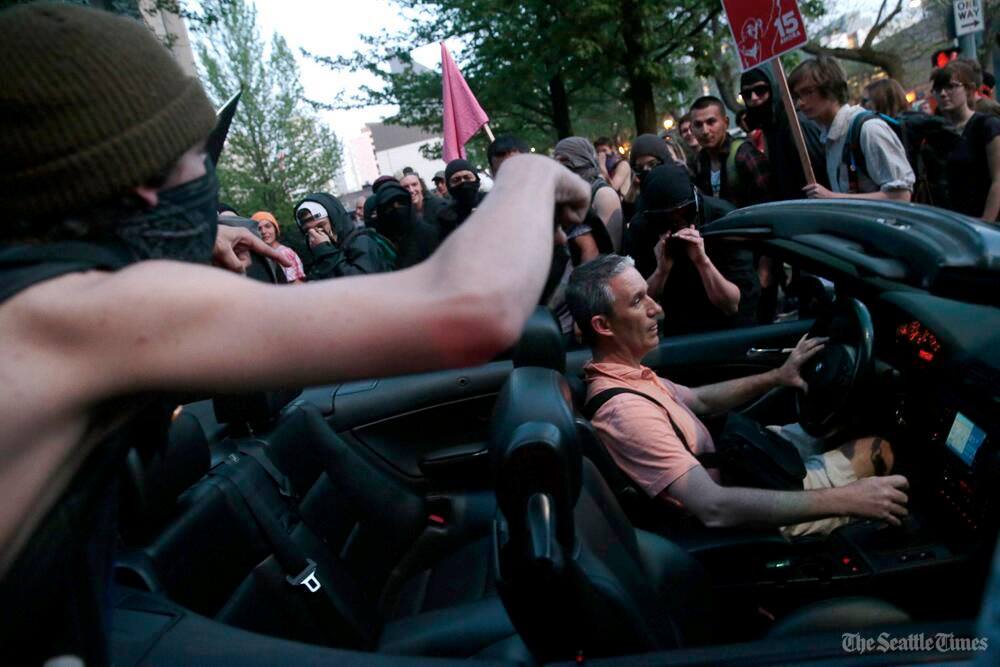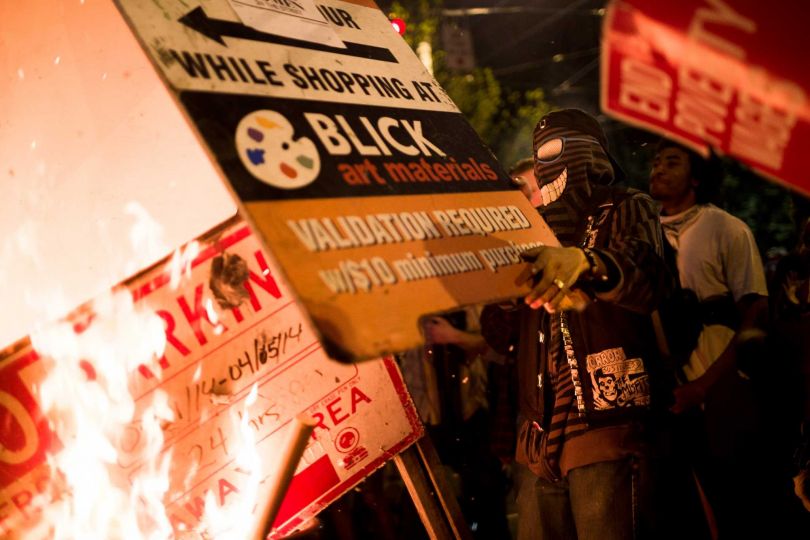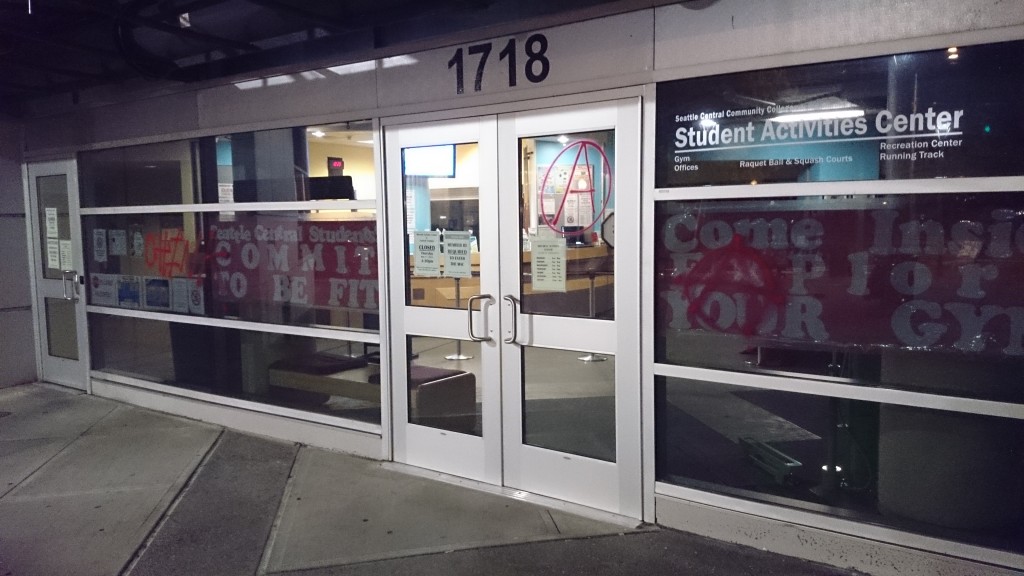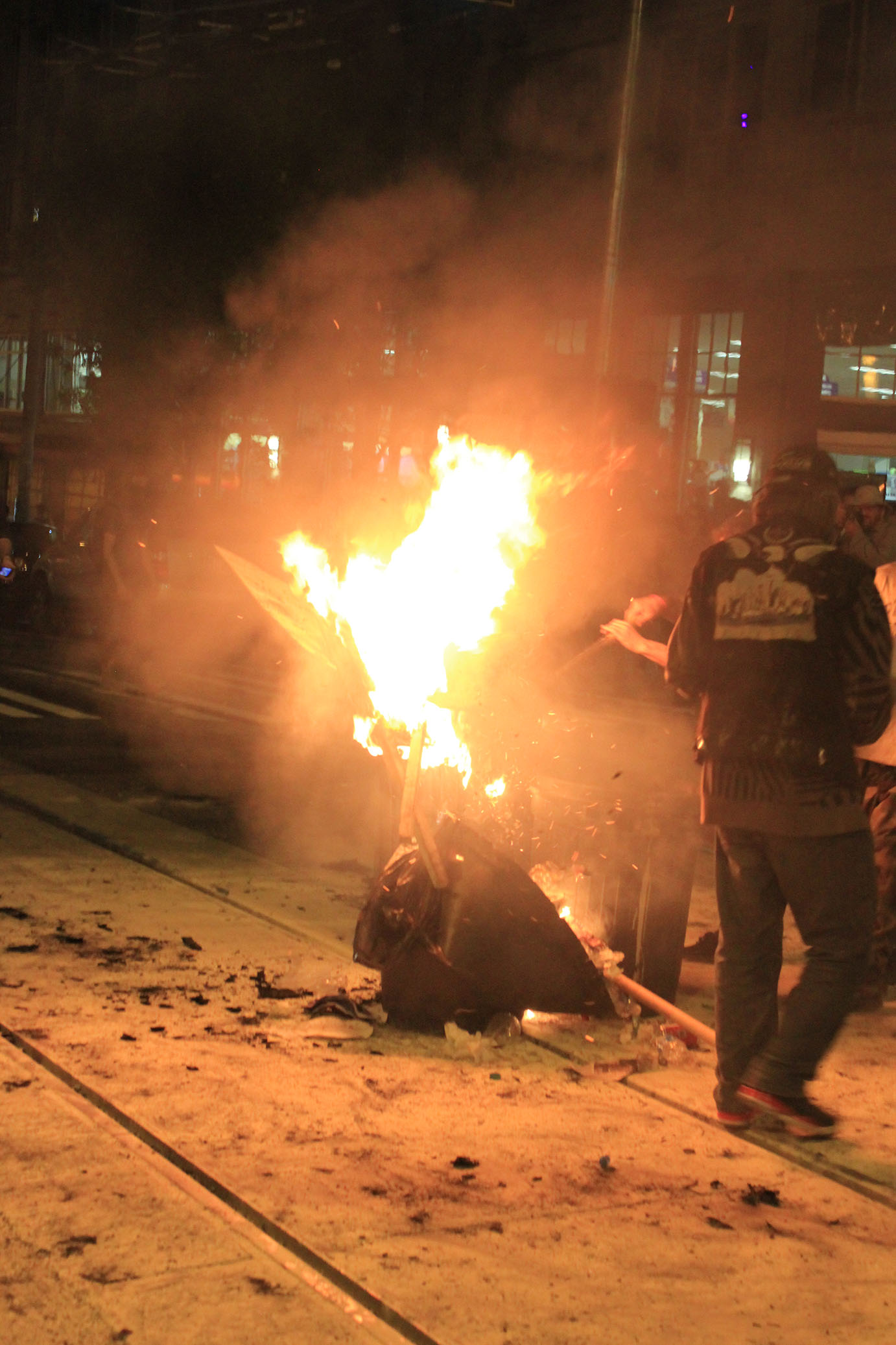
The following is not a report-back on May Day 2014 in Seattle, but rather a brief piece of inquiry and research. It therefore excludes many events from the day in question, though some of this (such as the issues raised by the earlier Immigrant Rights’ march) will be returned to in later articles. Note: Based on discussions with others, a few things have been freshly highlighted, and others that were cut for space have been added back in from earlier drafts to clarify several more controversial points.
The Roving Crowd
We were chasing after disparate pods of people who had come for a march no one could seem to find. It was supposed to have started at the Juvie, but by the time we showed up there were only a handful of folks with a sound-system surrounded by hundreds of armored police. Helicopters swooped low overhead. People crouched down to shield themselves from the sound as they yelled through their phones, trying to figure out where the march had gone.
By the time we caught up with it, the crowd was downtown, following a meandering path with no one in the lead. There were hundreds present, mostly young people who looked like they’d never been in a march before, their eyes shining from the sheer power of it. Everything echoed. The cops kept their distance.
But Seattle’s squad of right-wing vigilante “superheroes” led by Phoenix Jones, didn’t. Two of them, one dressed in a purple paramilitary getup, another in—I’m not even joking—a red Power Ranger outfit, began to antagonize the marchers. Someone shot the Power Ranger with silly string and the one in purple threw a punch into the crowd. A tall, muscle-strapped man with no shirt leapt out, hooked the purple one by the neck and took him to the ground. The Power Ranger was surrounded, body-slammed and stomped on by anarchists and street kids with sticks. When he got up again his helmet was missing and his face was red and sad, like Peyton Manning.
In Belltown the streets and buildings seemed miles apart. A lady in a sundress stood on the balcony of a shining new apartment complex. She flipped off the crowd and the crowd responded so she flipped them off some more. “Get a fucking job!” she yelled, sipping cool wine from her shaded balcony—she and all the others on the rooftops favoring skyline over streetside. Some of them yelled down insults, others offered thumbs up or peace signs from above, themselves old leftists long since bought off.
A few blocks down the crowd surrounded a convertible. People pointed and yelled at the old white man driving it. Some were service workers staffing the kitchens, malls, hotels and hospitals that attend to the needs of the man in the convertible. Others were street youth, regularly attacked and imprisoned by police to make the city’s shopping district more appealing for men like this. Someone pushed up against the hood of the car. The man was wearing sunglasses and staring straight at the steering wheel, trying not to make eye contact with the frightening horde that makes his own life possible. A nearby construction crane cast a shadow over the vehicle. People closed in and, for a moment, it seemed like the man just might be pulled out of the convertible and dragged into the sunlight with the rest of us. But then the crowd surged, people started walking and the police moved in to build a human wall between the wealthy man and the mob.
We walked shoulder-to-shoulder toward the northern edge of Belltown. Giant, half-built structures cast a heavy shadow in the dimming light. “Now Leasing” banners flapped quietly against chain-link fences, the only movement in the tall, gleaming landscape. Many of us had walked these streets since moving to Seattle, but they only feel like “our” streets in moments like this. The air around us felt electrified by the sheer magnitude of bodies.
Some people held hands. Others smoked weed or passed around a bottle. One woman burned sage and a man rode around on a tiny motorized scooter. Anarchists were scattered across the crowd, the black bloc lost like drops of oil cast in flowing water.
My friends and I stopped for some water but, as I was digging in the bag, I was shoved from the side and went stumbling backward, almost spilling everything out onto the pavement. The police had cut into the march, charging toward us. “Shit!” someone yelled. I heard the snake-hiss of pepper spray. Then we were being pushed by the entire crowd as everyone rushed away from the burning mist and police batons. The crowd was smashed up against a construction site. I pulled my hood over my head and turned toward the chain-link fence, scared to look over my shoulder to make sure my other friend was with me. But then I felt her hand on my back.
As we pushed our way out, the electric energy of the march dissipated into shock for a moment. I saw a man I’ve met at a few meetings being escorted by medics on both sides as he struggled through the pain in his tear-flooded eyes. I saw someone begging for water for a friend. But our disorientation ended as soon we were safe under a nearby construction scaffold, gulping down water and checking to make sure we hadn’t lost anyone. We cut around the block to catch up and keep going.
People seemed frustrated that the march was going in no particular direction. Some yelled that we should head to Amazon, but no one seemed to listen. “Left!” people from the back yelled toward the smiley face banner at the head of the march. There was no response. The giant smiley face stared silently.
“Get out of the fucking road!” yelled a man in a beamer. He wanted the protesters out of the way so he could move about as usual.
But it was exactly this “usual” movement that the march had turned on its head. Walking in the street seemed distinctly unusual—but why? Are our movements more fixed and determined than we think they are, limited to certain actions, certain walkways, certain possibilities? And who is even allowed to move in the first place? What if you can’t?
“MOVE,” the cop had kept shouting as I was trapped against the chain-link fence like an animal. “MOVE!” But I couldn’t. The cloud of pepper spray was dispersing and I wanted to get away, to protect my eyes—to disperse myself.
But soon after this, shouts of “move” came from the protesters as well—to the journalists and cameramen but also to themselves to keep marching, not just ahead but rather toward some coherent target. When some news crews entered the crowd they were immediately deemed adversaries and subsequently silly-stringed or otherwise hindered. Yet other journalists joined the march unmolested; at times they were even welcomed. What explains this contradictory treatment? The “adversarial” reporters as a whole didn’t do much to make themselves welcome with their hired thugs, palpable corporate vibe, and questions rife with criticism. More than once, I witnessed journalists verbally harassing protesters, playing the same role as the people up on their balconies flipping us off.
We soon skirted up against South Lake Union. Once a maritime industrial zone, the area has since been transformed into a giant construction site by Paul Allen, who bought much of the neighborhood after failing in his attempt, in league with Democratic politicians back in the ‘90s, to loot a hundred million in public tax dollars in order to construct a Central Park in the middle of his own property holdings. As Allen used his Vulcan investment firm to purchase and demolish many of the existing properties, other hi-tech firms began moving in, capped today by Amazon’s newly-approved headquarters, complete with Biodomes to shield its employees from the harsh reality of the outside world.
South Lake Union, alongside all of central Seattle, is being intentionally redesigned by people like Allen to become a sort of urban palace where the truly wealthy—those millionaires and billionaires who are the real owners of the majority of the world’s infrastructure—can rub shoulders with the highest paid engineers, medical researchers and Google Glass-wearing snobs in a high-class cultural setting. Recent blockades of Microsoft shuttles and Uber taxis in Seattle, modeled on similar blockades in the bay area, have called attention to the phenomenon. Yet some still decry the fact that poor service workers, street youth, students and the unemployed might target other workers, even if well-paid ones. After all, the man in the convertible may well have been a cancer researcher or a coder at Amazon.
But the man in the convertible is nonetheless the ally of the oligarchs, not the fucked. This “they’re workers too” approach is a common error in which people take ideal categories of class, or ideal pictures of what political action should be, and try to force-fit real events to those abstractions. “Class Unity” becomes little more than a pipedream of a proletariat holding hands across intraclass divisions. Our practice should, however, be opposite. We must abstract from the real phenomena, starting with the divisions that presently exist and the dynamics presently in evidence. Who is here—who has chosen to be an antagonist? And why do they perceive *these people* and *these things* to be (or symbolize) enemy? These are questions, however, not conclusions. An equally absurd position, taken by many anarchists, is to idealize present class divisions themselves, treating them as if the wall between palace and prole does not shift, and forgetting that even those who remain courtesans are capable of defection. This not only makes for bad strategy, but is also a moralistic approach that ultimately degenerates into the worst sort of identity politics.
These ideal approaches confuses absolute or immediate structural positions within the global division of labor with tactical questions about the current conflicts and allegiances distributed across that system presently, and how those conflicts and allegiances might evolve in the future. The class as the current amalgamation of all those who do not own the means of production must, for the “workers-too” critics, evolve into the class that makes the revolution, though maybe shedding a little reactionary dead skin in the process. This seemingly Marxist position often appears correct on an intuitive level. It is true, for example, that the millionaires and billionaires—the royalty of the urban palace—are the absolute enemy, and, relative to them, the coders at Amazon, the lab techs at the cancer research center or business majors pushing paper for the Bill and Melinda Gates foundation are all “on our side,” if only because they own a miserable pittance compared to the world’s real rulers. But palace courtesans, if not royalty, are still presently members of the court. Unlike us, they are not the servants living in the bowels and the shadows of the palace, fighting to feed families that lie far beyond its walls. Ignoring this fact is as fruitless as pretending that the present divisions are eternal, as if courtesans will not themselves be ejected from the palace when profit margins are too thin.
As we trudged up the last hill, I could only speculate about the meaning behind the faces of the people in the cars that we flooded past. Most of them looked expressionless—not in a fearful way, but more like a combination of shock and calm preparation for something that might happen, something liberating. They’re seeing people taking space in new ways, showing that it’s ours to take.
One man wasn’t watching silently, though. He opened his car door and climbed on top of the roof, raising his fist into the air and shouting with us. The roof bowed under his feet. Maybe he’d been waiting for this moment.
The Fire
By dark we were back on Capitol Hill. People dragged the sound system onto the lawn of Seattle Central and others danced in the intersection of Broadway and Pine. Police moved in to clear the street, only to themselves be encircled by the crowd and forced to retreat—the crowd now echoing the police chant: “MOVE!” “MOVE!” as the bike cops flailed backward. Once they were forced out, someone dragged a trash can into the center of the intersection and set the contents on fire. Advertisements were pulled from the walls of nearby shops and cast into the flames alongside No Parking signs. Black flags were dipped in the blaze and transformed into torches.
Despite the media’s portrayal, the crowd itself was hardly composed of anarchists. Those from the city’s anarchist scene probably numbered in the tens, making up only a fraction of the hundreds present, though plenty of others had latched onto the symbols of anarchism in an intuitive way, like the high schoolers who showed up with Circle-As painted on their faces.
Ever since the riot of May Day 2012, the day’s events have taken on a life of their own. On May Day 2013, the march was composed in large part of street youth, who, when attacked by the police, simply fought back—the media deeming it a riot after the fact. This year the trend was further confirmed. Street kids were again a significant portion of the crowd, probably the largest single bloc. But, in all, the march seemed to have gathered a diverse swath of youth from every part of the city, many of whom looked to have never been to any sort of protest before.
A tattooed juggalo spotted some friends driving by and waved them down, blocking traffic as he stood there chatting through the window of the truck. Two young Vietnamese women were given the megaphone and they took turns yelling vague call-outs to the crowd. “This is about, like, hope, and how we need to be free and you can’t stop us when we get together!” the first said, handing the megaphone to her friend. “Yeah! I believe in love, and you shouldn’t keep people from being who they want to be.” They giggled to one another, slightly embarrassed that hundreds of people were listening. “And fuck the police!” she yelled, the crowd cheering. Her friend grabbed the megaphone, “Yeah! Fuck the police!” The crowd echoed them. They handed the megaphone off to someone else. “The cops beat up my brother in Tukwila,” one of the women said matter-of-factly, after the megaphone was gone.
A kid in a Seahawks Super Bowl Champions hat jabbed at the fire with a stick. Another used it to light her cigarette. Aside from the fact that most of the participants were young, there were few other demographic consistencies. People filtered in and out of the crowd from its edges. Some white bros with tribal tattoos sat with us in a circle near the fire, explaining how they’d joined the march in Belltown after seeing a beamer surrounded and police beating marchers back to protect the rich people inside. They were metal workers from Everett, they explained, staring up into the flames. They’d come to Seattle to get fucked up for the weekend, but found this instead. The riot police started moving in the background. People took selfies and date photos in front of the burning trash can. The bros offered us a drink from their bottle of whisky, the fire reflecting in their eyes.
I began to realize that, if you subtracted all the anarchists, activists and self-described “anti-capitalists” from the scene, this yearly “anti-capitalist” march still would have happened—and in largely the same way. If this was something that “we” as radicals had somehow created, we’d created it in the riot of 2012, not 2014, and even then only as a product of something much larger, in the form of Occupy. The day was no longer “ours” in the way that many anarchists and activists seemed to hope. Instead, the night belonged to the rabble—that name for a mass of people transformed into something dangerous and unpredictable.
But the rabble always has a monstrous dimension. Many radicals, sensing this incivility, feigned at the sight of it. They cast disapproving looks toward street kids and young black men calling cops “bitches” and making homophobic jokes. Others seemed wary that black flags were being burned alongside corporate adverts. Later I’d hear some argue that “those weren’t my comrades,” expressing fear that the crowd wasn’t staying politically on point. Confronted with the ugly conflicts in peoples’ consciousness, some attempted to disavow or forcibly correct those who didn’t conform to their purified ideal of political action, an attempt that was as futile in the moment as was the earlier effort to move the roving crowd toward some coherent political target.
And this wasn’t simply discomfort on the part of the more politically “aware.” Degrees of discomfort are a normal experience in the midst of a unruly crowd facing off against the police. Instead, the activists’ wariness hinted at a real resistance to accepting that these reactionary attitudes were a product of what “we” were in the moment.
There was an attempt to maintain the illusion that a more delimited “we,” as radicals, militants, anarchists or whatever, were the real, self-aware actors in the situation, and that political articulations beyond or opposed to those that we ourselves formulated were somehow invalid—or, at best, that we were there to somehow help the inherently inarticulate express their anger in a politically sound way, like white allies paid in white guilt to translate black rage for the viewers at home. This is the activist illusion, which builds a wall between “us” and “them,” conveniently attributing all the errors onto these others who sit outside the scene.
A case in point: Sent a picture from May Day of potentially[1] racist graffiti at Seattle Central, scrawled alongside circle-A’s, Seattle’s half-defunct anarchist newspaper Tides of Flame posted a response:
This despicable graffiti presents us with an opportunity to explain to everyone that actual anarchists believe in the universal equality of every person on the planet. There are no inferior races and every division based upon ethnicity is false. We fight for the universal liberation of all people from the ruling class of capitalists and the tyranny of wage slavery. Anyone who does not believe these basic truths is certainly not an anarchist.
The FBI, local law enforcement, or other hostile parties could have placed this graffiti in order to demonize the anarchist movement. But it is just as likely that a young white person from suburban King County stupidly equated anarchism with their own racism, bigotry, and intolerance.
But what is the real purpose of this response? Despite its obvious validity, the authors’ definition of anarchism is relatively mundane. The real function, then, seems more to be the disavowal of these politically unpalatable segments of the crowd from a distance—a more developed version of the uncomfortable glances cast at the juggalos who were calling the people flipping us off from balconies pussies for not coming down to face us in the street.
And in doing this, the response itself engages in the same type of moralistic, finger-wagging disavowal of the rabble as is used by those spineless progressives who decry the “violence” of the protesters every year. It flees from the ugly reality of the world into a kind of Beautiful Soul Syndrome, through which anarchists can easily cut and run when faced with an unruly crowd that doesn’t conform to their ideal model of political action—a Beautiful Soul Syndrome that is, again, identical to that of the progressives, though with contrasting ideals of what protest “should” look like.
The anarchists’ response refused to accept the racist graffiti (or the sexist insults, the homophobic slurs, etc.) as an immanent component of what “we” were in that moment. This, of course, isn’t the same as accepting the racist graffiti itself—racism is self-evidently unacceptable—it is, instead, simply accepting the dangerous proximity of such dynamics to ourselves in these moments. The fact is that people, even when consciously mobilized against the present system, are going to bring all the ugly baggage from that fucked up world with them to the barricade. For us, as “radicals,” this baggage more often takes the form of the illusion that we are somehow the authentic political actors and these other people are simply a confused, inchoate mass that lacks potential for subjectivity or only becomes a subject insofar as it is incorporated into the anarchist scene or socialist organization.
Some of the superheroes appeared on the edges of the crowd, but a young black man in a fishing hat confronted them, yelling, “I bet you superheroes don’t get no bitches! No bitches!” His friends gathered behind him. The superheroes, outnumbered and slightly puzzled by the nature of the accusation, quietly retreated down the street to where the riot squad was gearing up.
There is no disagreement here about the necessity of overcoming the reactionary dynamics that arise in these situations. But calling someone out for saying “bitch” when you’re face-to-face with the cops is not only tactically dumb, it’s also not an earnest or effective way of confronting these tendencies—it’s just a kneejerk, guilty-liberal reaction that allows the scolder to wash his/her hands of the situation by distinguishing him/herself from those others who hold such bad thoughts. And the more developed response from Tides of Flame does exactly the same thing, erecting a wall between the “actual anarchists” and those outsiders who had infiltrated the march from elsewhere.
According to the author(s), the members of the crowd who wrote the graffiti, presumably alongside those who were yelling “bitch” and “faggot” at the cops, couldn’t be “actual anarchists.” The fact, aside from being obvious, is stated as a sort of accusation, charging that these people shouldn’t have even been present in the first place. Instead of being “actual anarchists,” the response offers that they may, in fact, have been police—this accusation the most convenient way to replace troublesome conflicts in peoples’ political awareness with the hidden actions of some conspiratorial outside force.
If not police, they were most likely “a young white person from suburban King County.” Here the authors betray not only their own beautiful, untainted souls, but also an ignorance that itself has problematic racial dimensions. They repeat the myth of the suburbs as a conservative white space from which bad politics originate, when, in fact, King County’s suburbs are the few areas of the region that have “majority minority” demographics, including some of the largest immigrant settlements in the state.
More importantly, it elides the real questions about race and gender raised by the prevalence of such attitudes by taking them at face value (in the case of the sexist and homophobic insults), and (in the case of the racist graffiti) problematically assuming the impossibility of racial tension and inter-communal conflict between people who are not white. Ironically, the Tides of Flame response to the racist graffiti repeats almost verbatim the liberal “racial violence” narrative established decades ago in response to events such as the LA riots, when a clear class conflict took on ugly racial forms. Not only do they seem to miscomprehend the racial geography of the city (with its diverse suburbs and white core), but they fail to inquire into how and why certain class divides might be taking a racial form in the present moment.
A real attempt to overcome the racist attitude of the graffiti (which, as in the case of conflicts in LA, was also anti-Asian), would have to inquire into the recent restructuring of Seattle Central, raising tuition rates for the community college to prohibitive levels for the city’s poor while purposefully marketing the school to the children of wealthy Chinese capitalists. A little more than a year earlier, one of these students was driving a newly purchased Mercedes at twice the speed limit in Des Moines, one of the Seattle area’s poorer suburbs, when he struck a nearby car, injuring three of the passengers and killing the fourth, a Latina woman from the neighborhood. The story went viral on local social media as well as in China when the student’s mother flew to the states and posted his 2 million dollar bail in the form of a cashier’s check, causing speculation on Chinese social media that he was possibly the child of an influential party bureaucrat or leading capitalist, and stoking suspicion that he would never show up to court. Locally, the double-standard was brutally apparent, and the rage caused by the event often took an ugly racial form, despite its clear class content.
This obviously doesn’t imply that a class politics can “emerge” from racism, or any such nonsense. It simply helps us to better understand the maneuvers of the internal enemy (in this case, racists), in order to overcome them. And this is only a brief overview of how such reactionary attitudes might begin to be understood and overcome within the space of a given struggle. But the style of engagement typified by the Tides of Flame response does not seek to overcome reactionary attitudes. Instead, it hopes only to create an illusory distance between us and “them.” Many anarchists in this position seem unable accept that, in the moment, we unwillingly share a certain collective identity with these people, aligned as we all are against police, court and royalty. Their bullshit is our bullshit. It is immanent to what we are in that moment, and we are as much in allegiance with the frightening aspects of the mob as we are with its real political potential.
This bullshit, then, can’t just be attributed to undercover cops or “white kids from the suburbs.” These things have to be confronted and overcome within the terms of that allegiance formed in the streets. This is what exercising power means. While some anarchists might attempt to flee or to purge the rabble from the rabble itself, leaving only activists, scenesters and cops, we must instead embrace the monstrous dimension of the rabble, because it is only in this monstrosity that we find the potential to overcome the present.
It is the very incivility of the mob that strikes fear into the hearts of wealthy liberals—the unpredictability of whether the crowd will pull the rich man from the convertible or simply keep marching on. Power can take a frightening form, but it is the utmost cowardice to run from it. We must, then, not only enter into allegiance with the hooligans, the rabble, the impolite mob, but also become these things. And when that gets ugly we can’t flee from it, because we are it. The counter-revolution immanent to the revolution can only be overcome from within. When this fails, we find ourselves in another Egypt or Ukraine.
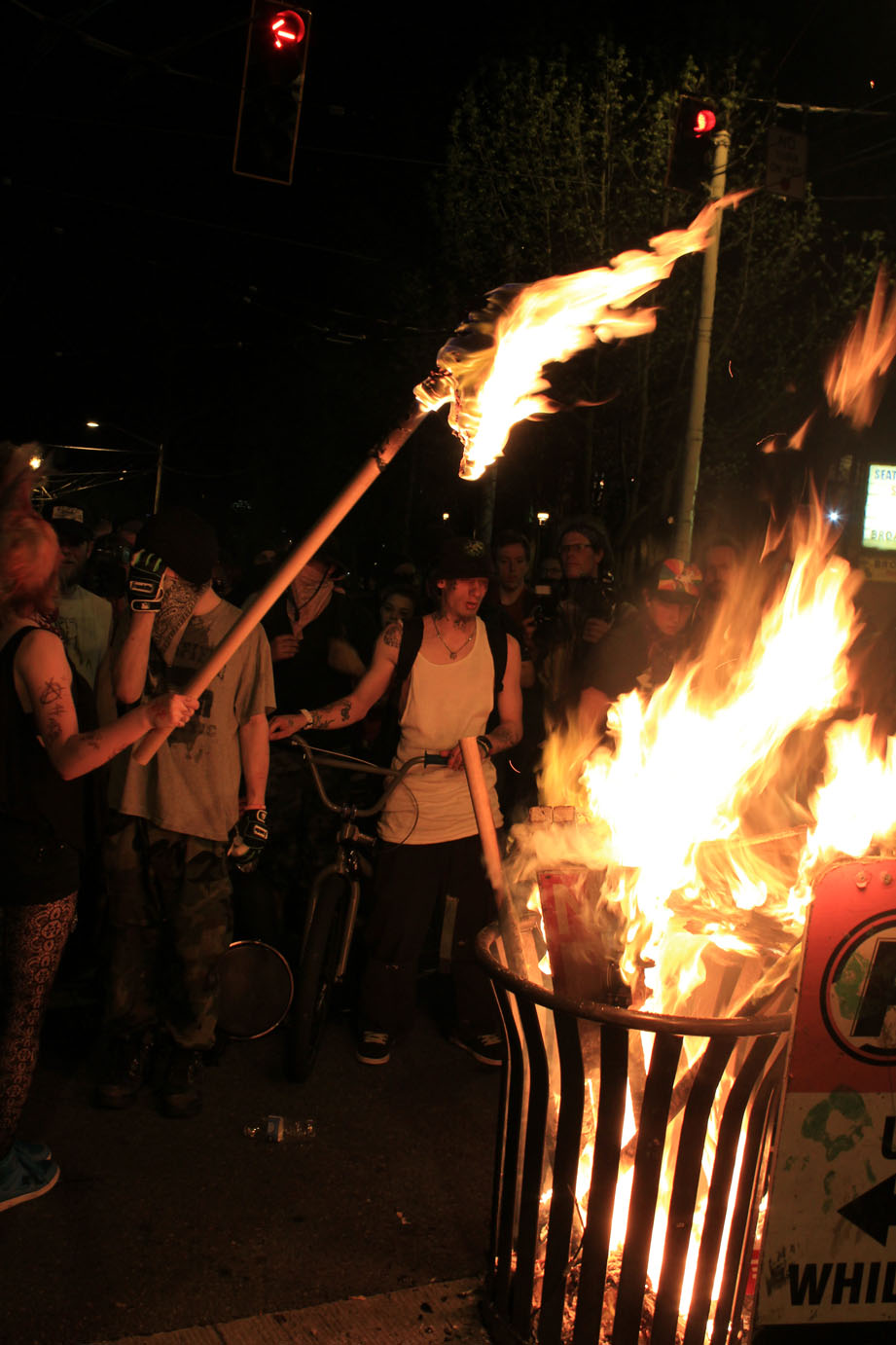
Any inquiry must begin with those who are engaged in a situation, not those deemed to be the proper representatives of that situation, anarchist or otherwise.
In order to understand what this entails, the dynamic of the event itself is the starting point. Rather than asking who should or shouldn’t have been there or who was properly representing the anti-capitalist “message,” we instead start from the question: who are these people and why are we here? This is the tip of an iceberg—what lies beneath?
In debating who is an “actual anarchist” or how to insult the wealthy and their police in the most politically correct way, we miss the most important facts. Here is an event in which juggalos, youth from the south end, street kids, students, steel workers, waitresses, immigrants and, yes, anarchists, all gathered together to face off against the police, to seize space on our own terms, to fuck with rich people and to light fires in the street. What do these individuals with such disparate backgrounds and identities all have in common? Why are we here?
The most salient similarity was, of course, our youth. Despite disparate backgrounds in race, gender or subculture, the generation itself—Generation Zero—was the first unifying factor. But there was no “unity” here in the sense of shared demands, even generational. Such unity-by-age is something that is of necessity overcome, as in Egypt when people from all backgrounds flooded into the occupations, unifying around their shared rejection.
The second unifying factor, then, was this demandlessness itself. People were unified through the wielding of power. This involved not only shared rejection—in the form of the acknowledgement that the present system is fundamentally fucked—but also the shared will to seize space, confront the police and target the wealthy in an active way, without begging favors of them or requesting that “corrupt politicians” and “bad apples” be changed out for better ones.
And our role as ultras, anarchists or simply more active components of this mob is not necessarily to lead the crowd toward clearer targets, to better communicate the “anti-capitalist” message, or to simply smash more shit and light more fires, though all of these things might at any point in time become smart maneuvers in the advance of a given battle. When we act, we act as a part of the mob, not as something external to it. Our tactics and propaganda spread laterally through the crowd, catching on primarily through action, example, or style, and only secondarily through argument and debate.
Despite the fact that this Seattle anti-capitalist march is, today, little more than a recurring night of riot and revelry, situations such as this are becoming more and more common. Riots are coming, and the mob will again become the central terrain of politics. For “militants,” “anarchists,” or “revolutionaries” to have any function in these things, we must first be subsumed by the mob. Only then can we act on and through the mob, working to transform it even as we are a component part of what is being transformed.
If our goal is to better coordinate, extend and deepen the conflict in the long term, we must first acknowledge that the conflict far exceeds us, and we are only a small fraction of its combatants. Strategy is not the product of distant thinkers sealed off in the sensory-deprivation chamber of the sect, but is instead one possible outcome of conflicts running up against their limits. Strategies may be authored and advocated by handfuls of people, but they are only strategic when they are embedded in the actual terrain of the conflict. So it is only here, as an immanent part of the unruly crowd, that we will be able to strategically overcome the potentials for counter-revolution that sit within that same crowd—evidenced by the amphibiousness we have seen in the hard-to-categorize soccer ultras of Europe, who sometimes fall far to the left, sometimes far to the right, depending on the larger dynamics in play.
Suddenly the police charge in again, this time in riot gear. Our circle breaks up as people scramble for the sidewalk. The cops extinguish the fire, leaving a cloud of ominous white smoke floating in the middle of the street. Once the fire is out, however, the police simply leave again—part of the new interim chief’s hands-off approach to these protests. People filter back into the intersection.
The crowd yells “Set it on fire!” and in a few minutes the fire has started again. Someone grabs a second trash can and throws it next to the first. Things pop and explode inside the fire and people take a step back, sensing that the blaze may soon get out of control. “Set the fire on fire!” people yell.
Someone lifts a black flag that is now nothing but a flaming stick. It is the lone light held up against a city sky hollowed of stars.
“Set the fire on fire!” people yell again, almost desperately.
Set the fire on fire.
—Seattle Ultras
[1] Some have suggested that the graffiti was the work of a known tagger trying to reclaim a racial slur in an affirmative way, but it’s unclear whether or not this is just a rumor.


